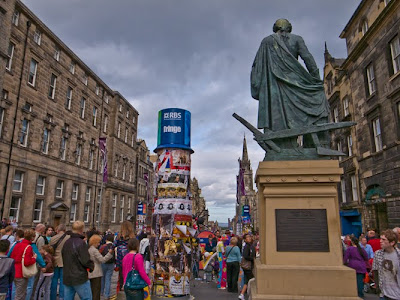
Part of the delight of being in Edinburgh during the festival month of August is to roam the streets watching the jugglers, musicians, singers and actors performing, advertising their shows or just wandering about in costume (sometimes it’s unclear whether the gaudily dressed person ambling by is from a show or not – maybe they always look like that). Amongst the mostly vigorous and noisy performers there are always “living statues” dotted around, posing stationary on bollards and chairs. This year being painted head to foot with silver or gold paint was popular with many of them, as was occasionally moving, often to the surprise of observers. The highlight of the street entertainment for me this year was blues singer
Richard Blues, who mixed sharp patter with neat guitar work and soulful singing. A few weeks before I heard him someone videoed him and uploaded it on to
You Tube where there are several other videos of him in Edinburgh and London. He’s been in Edinburgh in previous years but somehow I’d managed to miss him. I shall look out for him in future.
Apart from the outdoor themed shows I’ve reviewed in my last three posts I saw eight other shows. (I must here give credit to my partner Denise for spending time going through the Fringe programme and selecting shows she thought I would like – she does enjoy doing this!). All were classified as theatre rather than comedy though several were funnier than comedians I’ve seen at the Fringe – this year we decided not to bother with comedy shows as too expensive for what they are unless you happen to hit on one that is really funny amongst the myriads claiming to be hilarious.
Having enjoyed it last year we again went to
Shakespeare for Breakfast, where you get a hot drink and a croissant to go along with a lively and amusing interpretation of a play, this year A Midsummer Night’s Dream.
A Midsummer Night’s Dream popped up again in
Terry Pratchett’s Lords and Ladies, an amusing story of elves, witches and wizards that references Shakespeare frequently. Performed with gusto by a student theatre group from Southampton University this was a fun show with Terry Pratchett’s wit, humour and imagination providing good entertainment as always, with just that edge of disturbing seriousness that makes the stories more than just good romps. The performances were enthusiastic and lively. Magrat, one of the witches, and the totally balmy Dean of the Unseen University were played particularly well.
Long before Terry Pratchett another fantasy writer mixed humour with grimness. As a child I always found Lewis Carroll’s Alice tales disquieting and dark though I still loved them. In their stage version of
Alice Through The Looking Glass Daysleeper Productions brought out some of the paradoxes and possibilities of the story and added touches of Victorian vaudeville and decadence. The small set consisting of a revolving wardrobe and various flaps and boxes worked well, allowing the excellent cast to conjure up the various scenarios of the story. The sense of mystery of the original was well caught along with the incipient cruelty and bullying. Never have flowers seemed so sinister!
Bullying turned up again in another version of a Victorian Classic.
Broken Holmes by Robin Johnson has Sherlock Holmes as an arrogant and abusive drug addict who treats the sensitive and thoughtful Dr Watson appallingly. The play is a very funny farce, well-acted, especially by James Bober as the manic Holmes, and with many references to Holmes stories.
Moving back in the history of English literature
Geoffery Chaucer Lives features two of the Canterbury Tales as told by actors playing four immortal alchemists who are travelling through the ages with Geoffrey Chaucer’s unconscious but still living body. The production is witty and entertaining and the crudity of the Miller’s Tale is a reminder that some of the “shocking” comedians at the Fringe are perhaps not as modern as they think!
Returning to myth and fantasy but without much in the way of humour Siege Perilous’s
King Arthur was a serious play about political power. Written in blank verse by Lucy Nordberg it was at times hard to follow, partly due to the unclear and hurried diction of some of the cast. The story is fairly true to the Arthurian legends and only the modern dress suggests a link to today’s politics. I quite enjoyed it but felt it could have been done much better. It has received good reviews so perhaps the cast were having an off day.
The highlight of all the shows I saw was a modern drama about a very serious and depressing subject.
In Search of Miss Landmine tells the story of an Angolan girl who loses a leg when she steps on a mine and then goes on to win a beauty contest for land mine victims. Woven around this are facts about landmines and the story of the 1997 Mine Ban Treaty. This doesn’t sound promising material for an enjoyable play and we probably wouldn’t have thought of attending if it hadn’t been for the company putting it on - Teatro Dei Borgia- who we had seen and been impressed by at the 2007 and 2008 Fringes. The high quality continued with Miss Landmine. The acting was superb – powerful, emotional and gripping. I’d be happy to see this company in just about anything.
Photo info: Living statue on the Royal Mile. Ricoh GRD III, 1/800@F5.6, ISO 64, raw file converted to JPEG in Lightroom 2.4









